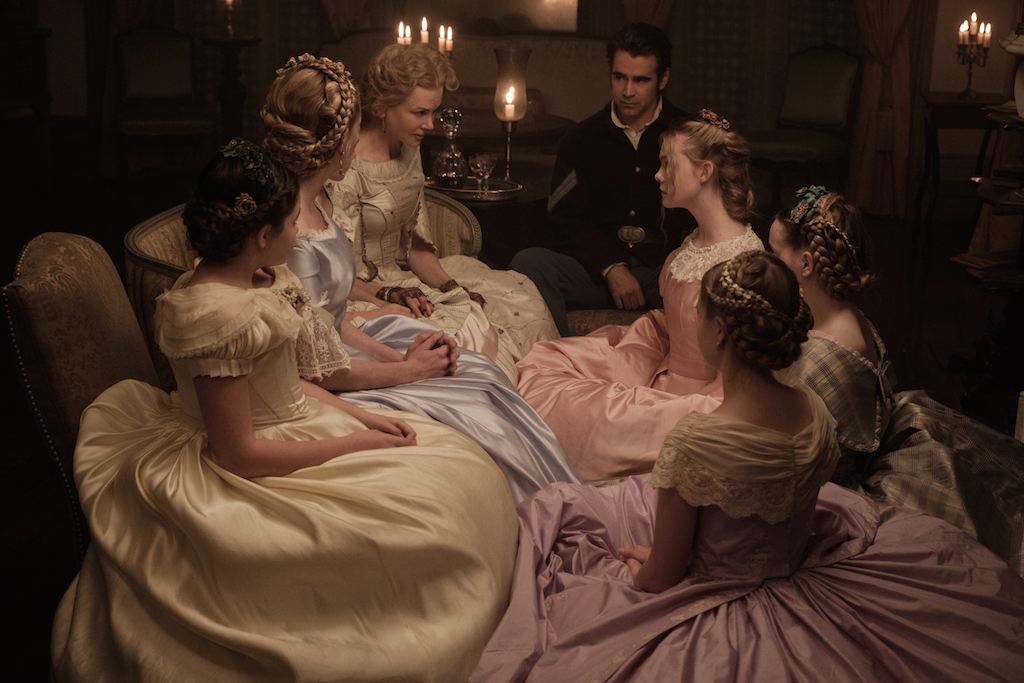
Don Siegel’s 1971 film The Beguiled was a het-up, gothic bodice ripper-cum-horror film that had three Southern belles—a virgin, a spinster, and a bad girl—competing for the attentions of the wounded Union corporal (Clint Eastwood) they were harboring in their girls’ school during the Civil War. The film’s archetypes were retro and undeniably sexist, but they got the job done. The stakes were clear.
In adapting the same novel that Siegel used as his source material, Sofia Coppola makes some subtle changes. Instead of focusing the film largely from the soldier’s perspective, she focuses on the rhythms and rituals of the girls’ academy. And the archetypes are less pronounced. Teacher Edwina (Kirsten Dunst) is still demure and proper as she was in Siegel’s film, but she’s not explicitly a virgin and, indeed, seems to lust for both adventure and the Union soldier (now played by Colin Farrell). The bad girl Alicia (Elle Fanning) is not nearly as audacious as her 1971 counterpart (Siegel’s Alicia seemed more like a sexually liberated refugee from Woodstock), although she makes her intentions toward the corporal clear.
But the biggest change comes in the form of Miss Martha, played by Geraldine Page in the original and Nicole Kidman here. Page, while a wonderful actress, was never a great beauty, and her character’s stern matronliness seemed to come at least in part from her sexual repression. (The original even includes a bizarre backstory that had her in an incestuous relationship with her reprobate Confederate soldier brother. Thankfully, Coppola jettisoned that.) Nicole Kidman, however, looks like, well, Nicole Kidman. (She’s particularly stunning in her Scarlett O’Hara-style corseted dresses and flat-brimmed hats.) As with Page’s Miss Martha, she is strong, formidable, a mother bear protecting her cubs. But when the soldier—whose true nature is still uncertain at this point—flirts with her, we don’t get the sense that she’s being played, as we did when Eastwood set his sights on Page. Indeed, it would be shocking if he weren’t drawn to her. In a strange way, I think Siegel’s retro version serves the source material better. That being said, much of what Coppola has done is marvelous.
It’s clear that she has been itching to make a gothic film and she luxuriates in the genre. Her film is filled with gorgeous images of hulking, mossy trees casting ominous shadows in the gloaming and bursts of intrusive sunlight creeping through the curtains in dank rooms. Coppola, unsurprisingly, is also is obsessed with the accouterments of these Southern Belles—hair ribbons, broaches that clasp the necks of their proper gowns, candelabras, fine china. She manages to tease some wonderful humor from her story, too. In the film’s best scene, the corporal joins the belles for dinner. Coppola’s camera slowly pans to each of them—all dressed up, batting their eyelashes at their male guest. It is remarked that Alicia made the apple pie that the corporal is enjoying. “From my recipe,” notes Edwina. “And I picked the apples!” chimes in Amy (Oona Lawrence), the besotted little girl who had first discovered him injured in the woods.
If Siegel’s film bordered on pornographic, Coppola sexualizes the interactions between the soldier and the women in a more subtle way. However, a scene where Miss Martha gives him a sponge bath as he sleeps is far more erotic than anything in Siegel’s film.
Comparing the two films is an excellent case study in how different filmmakers can interpret the same story: Siegel’s film is lurid, overwrought, and decadent; Coppola’s film is moody and restrained and sensuous (although both have a fair amount of gore). The prevailing image of Siegel’s film is one of sexual mania. In Coppola’s film, it’s an image of female strength—Kidman, standing proudly on the porch of her school, ready to take on all comers. Pick your poison.
